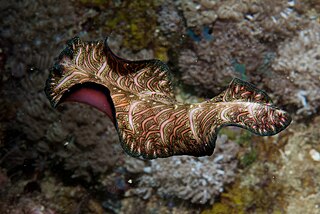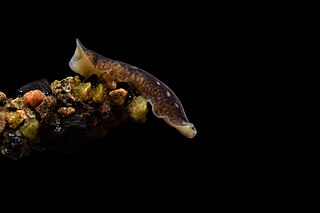
The flatworms, flat worms, Platyhelminthes, or platyhelminths are a phylum of relatively simple bilaterian, unsegmented, soft-bodied invertebrates. Unlike other bilaterians, they are acoelomates, and have no specialised circulatory and respiratory organs, which restricts them to having flattened shapes that allow oxygen and nutrients to pass through their bodies by diffusion. The digestive cavity has only one opening for both ingestion and egestion ; as a result, the food cannot be processed continuously.

Acoelomorpha is a subphylum of very simple and small soft-bodied animals with planula-like features which live in marine or brackish waters. They usually live between grains of sediment, swimming as plankton, or crawling on other organisms, such as algae and corals. With the exception of two acoel freshwater species, all known Acoelomorphs are marine.

Xenoturbella is a genus of very simple bilaterians up to a few centimeters long. It contains a small number of marine benthic worm-like species.

Convolutidae is a family of acoels. It contains more than a third of all known acoel species.

Acoela, or the acoels, is an order of small and simple invertebrates in the subphylum Acoelomorpha of phylum Xenacoelomorpha, a deep branching bilaterian group of animals, which resemble flatworms. Historically they were treated as an order of turbellarian flatworms.

Nemertodermatida is a class of Acoelomorpha, comprising 18 species of millimetre-sized turbellariform, mostly interstitial worms.

Nemertodermatidae is a family of wormlike animals in the phylum Acoelomorpha. They are similar to the flatworms of the phylum Platyhelminthes, and were traditionally classified as such.
Stummeria is a genus of planarian in the family Cercyridae. It is monotypic, containing the sole species Stummeria marginata.
Oregoniplana is a genus of planarian in the family Cercyridae.

Archicotylus is a genus of freshwater triclads belonging to the family Dendrocoelidae. It has largely been found in Russia in Lake Baikal.

Baikalobia is a genus of freshwater triclad in the family Dendrocoelidae. Species have been documented in Russia.

Papilloplana is a genus of triclads belonging to the family Dendrocoelidae.
Psedoceros reticulatus is a hermaphroditic marine flatworm species that belongs to the Pseudocerotidae family.
Micropharynx is a genus of planarian placed incertae sedis in the suborder Maricola.
Procerodes lobatus is a species of triclad in the family Procerodidae.

Acromyadenium is a genus of freshwater triclad belonging to the family Dendrocoelidae. It is monotypic, containing the sole species Acromyadenium maroccanum.

Baikalobia guttata is a species of freshwater triclad in the family Dendrocoelidae. It has been found in Lake Baikal.

Crenobia alpina, known as the alpine flatworm, is a species of triclad belonging to the family Planariidae. They are found across the Alps.
Hymanella is a genus of triclad belonging to the family Planariidae. Species have been found in North America.

Paraplanaria is a genus of triclad belonging to the family Planariidae.












